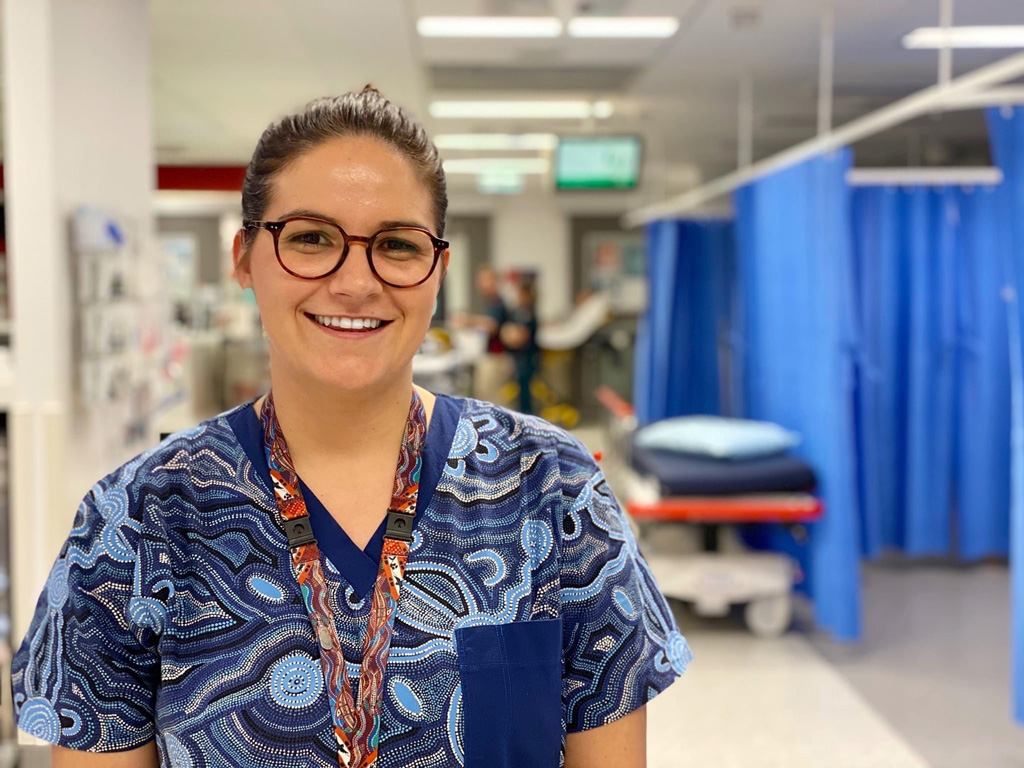After the daunting and at times terrifying ordeal of working in emergency nursing during the COVID-19 pandemic, it’s little wonder some nurses are taking time out.
As we continue to celebrate emergency nurses across the state for this year’s Emergency Nurses Week, today we hear from Kathleen Synot – Kitty – who is currently on a sabbatical after working in the Gold Coast University Hospital’s (GCUH) busy emergency department for five years, including during the pandemic.
“Before the pandemic, GCUH was the busiest ED in Australia, and then COVID came, and it just burnt me out. In the beginning, it almost felt like the world was ending, no one knew what was going to happen. Initially that made it more collegial – everyone wanted to help and to learn and I felt really grateful that I had a job because so many people lost their jobs,” Kitty said.
But as time went on, Kitty felt community sentiment changed and healthcare workers were perceived differently. “We became the punching bag for people because they were just sick of everything.” So, she decided to move out of emergency nursing and is currently a Clinical Nurse Consultant for patient safety in Metro North - her first non-clinical role which she saw as an opportunity to reflect.

“I know I want to go back to ED. It’s always been what I wanted to do. The time away has made me realise that.”
Kitty’s first placement in an ED was as an enrolled nurse, aged just 17, at Ipswich Hospital. “It was overwhelming at first because it was a bit chaotic. But I found it really exciting. I did CPR for the first time – I was told to get in line to help. I was so nervous my hands were shaking. Unfortunately, we weren’t able to save the patient. Afterwards, the team spoke about what happened and how we all did what we could. There have been a few doctors in my time who said it’s a privilege to be there when someone’s time has ended and to do what we can to make that transition as peaceful as possible.”
“One older male nurse - I always remember him and how he cared for people – told me for some patients, it’s the worst day of their life but you can do something to make it easier.”
The experience solidified Kitty’s love for emergency nursing. “It was the only time through all my placements where I felt like yes, this is where I want to work. I felt like I was doing something good.”
“I’m now going to try and get my nurse practitioner (NP) qualification. I think practising to full scope is the way of the future, especially if there is a shortage of nurses and doctors.” She would also like to continue her work in cultural safety.
Kitty led the Transforming EDs towards Cultural Safety (TECS) project locally at GCUH and is the Clinical Co-chair for the statewide roll out, which is supported by the PROmoting Value-based care in Emergency Departments Project known as PROV-ED. TECS is designed to reduce the barriers for Aboriginal and Torres Strait Islander patients engaging with hospital-based emergency care. “At GCUH I was one of two Aboriginal emergency nurses out of 380. In fact, we were the only two Aboriginal people out of the 800 people who work in the ED across all disciplines. There is a huge gap in Aboriginal and Torres Strait Islander emergency nurses – there are only a few across the state. There are not many hospital-based Aboriginal and Torres Strait Islander nurses at all – we only make up 1.4 per cent of the nursing workforce in Australia.”
Kitty said without representation of Aboriginal and Torres Strait Islander people amongst the staff, culturally safe care was harder to deliver. “I do see a lot of racism and I personally have been a victim of racism. They don’t consider the impact of colonisation and intergenerational trauma and how this impacts the burden of disease for Aboriginal and Torres Strait Islander people. There is a lot of missed opportunities in chronic disease identification and management because people don’t always ask if patients identify, there is sadly a lot of ignorance around this.”
‘It can be a difficult environment to work in,” Kitty said.
Kitty encourages other Aboriginal or Torres Strait Islander nurses or health workers to consider a career in emergency nursing. “There might not be a campaign that says, ‘you can do this’ or ‘this is an option for you’ – but it is an option, and we need you.”
Now she has had time out from emergency nursing, Kitty is looking forward to coming back. “It’s made me reflect on what it is to be a nurse and to be there for someone - not many people get to do that,” she said.
And to all the burnt-out nurses out there she says: “It can be traumatising and hard, but it’s a privilege to be there. And it’s ok to take a break!”